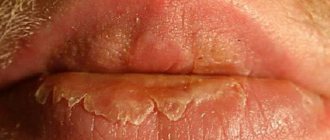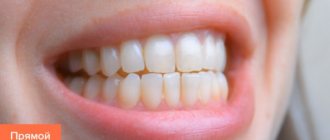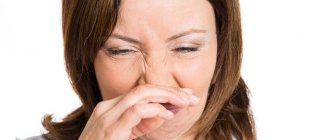14.03.2017
You can determine the condition of the internal organs not only by taking tests and doing an ultrasound, but also by looking into your mouth. In our article we will talk about how the method of determining diseases by the condition of teeth works and which teeth are responsible for which organs.
Many people have experienced severe toothache at least once in their lives. It happens that neither pastes, nor rinsing, nor modern toothbrushes, nor even professional cleaning help with caries and bleeding gums. So, maybe we need to treat not only teeth, but also other organs? According to some experts, there is a direct connection between teeth and internal organs. Diseases of teeth and dental tissues will help us determine this relationship.
But all this is alternative medicine, but academic medicine believes that problematic teeth may not be an indicator, but rather the cause of many diseases of internal organs. Let's still look at what teeth can talk about and what.
General conditions
Existing or past diseases manifest themselves in the form of various inflammations and diseases of the oral cavity, teeth and gums.
- If in childhood you suffered from severe flu or measles, then in adulthood this can result in diseases of the periodontium (periodontitis, periodontal disease) and teeth (pulpitis).
- If your body suffers from a lack of water or it is difficult to remove it from the body, do not be surprised by bleeding and gum inflammation.
- Vitamin deficiencies, especially a lack of vitamin C, are the cause of loosening and even tooth loss.
- Diseases of the gastrointestinal tract manifest themselves in the form of a whitish coating on the tongue, cracks and inflammation of the tongue.
Stages of disease development. Where does the disease begin?
The most unexpected microorganisms can cause severe and fatal illnesses. Now let's look at the chain of development, that is, the cycle of transformations from health to illness and the death of an individual. At school we studied the cycle of life in nature, the water cycle, watched interesting films about animals, about the food chain.
But at the same time, we have always considered ourselves “Kings of Nature,” not assuming that inside us, in our body, the same cycle of different lives is possible, coming and going, but living by eating our cells, each other, or feeding on other people’s scraps. Everyone has the same motto: “Survive at any cost, winners are not judged!” This means infiltrating into the best place, individual for each specific type of parasite, finding food for growth, reproduction, protecting its offspring and helping it spread.
So let's look at this process. Sparing the feelings of convinced atheists, I will start not with the true causes of the development of diseases - spiritual, energy-informational, but with “materialized” ones, that is, those that can be seen, touched, identified, calculated and measured. These reasons are the microorganisms living in us. I will paraphrase the Bible saying “what is outside of us is also in us” to “what is on the earth and in the air is also in us.”
Let's consider the process of disease development and the role of various microorganisms involved in it. The trigger mechanism for the development of the disease is viruses. They are able to penetrate cells, weakening them or completely destroying them. These do not necessarily have to be formidable viruses specific to immune cells. Any other viruses that penetrate us from childhood gradually lead to a weakening of the immune system, a weakening of the protective properties of cells, organs, and systems.
Each organ has its own tooth
It has been known since ancient times that the condition of a particular tooth can determine the disease in the corresponding group of organs. Today this is a scientifically proven fact. For example, by using the incisors above and below (teeth 1 and 2), diseases of the ears, bladder and kidneys can be diagnosed, and by the canines (3) the condition of the liver and gallbladder can be determined. Small molars (premolars 4 and 5) transmit data about the lungs and large intestine, and large molars (molars 6 and 7) about the stomach, spleen and pancreas, and the so-called “wisdom teeth” can tell about the condition of the heart and small intestine .
At the same time, affected teeth identified by a dentist during an examination do not always mean the presence of diseases in the corresponding internal organs. It happens that a patient presents with pain in apparently healthy teeth or even with phantom pain (a painful signal comes from an internal organ to the site of the extracted corresponding tooth). Knowing about these relationships, it is easier to identify the affected organs.
LiveInternetLiveInternet
Sunday, October 11, 2015 11:48 + to quote book
Teeth in dentistry are marked as follows:
Right side. Left-hand side.
Permanent dentition teeth
In mammals, the change of teeth and the growth of the dentition occurs from front to back (first the central incisors, then the lateral incisors, canines, premolars, molars).
Teeth react to internal problems in the body; each diseased tooth is directly related to the ill health of one of the internal organs.
Thus, the liver is projected at the level of the lower canines, the condition of the pancreas can be judged by the small molars, and diseases of the joints of the legs can be judged by the front teeth of the upper and lower jaw.
What is happening in the stomach or intestines can be judged not only by the teeth, but also by the condition of the gums.
In most cases, those suffering from stomach or duodenal ulcers develop periodontal disease. In addition, with a stomach ulcer, abundant tartar deposits necessarily appear on the teeth.
Therefore, by opening your mouth in front of a mirror, you can get comprehensive information about what is happening inside your body. Depending on which tooth suffers from caries, you can judge which internal organ needs help.
And if the same tooth hurts not for the first time, this indicates that the disease may have gone far enough, and measures must be taken urgently, and in addition to the dentist, go to another specialist. If the process is not stopped, the diseased organ will again send its signals for help to the tooth.
In turn, caries can cause constant migraines. Moreover, the tooth itself sometimes doesn’t hurt. Headache in such cases is attributed to anything from the flu to a magnetic storm. This happens especially often when the teeth of the lower jaw become inflamed and the whole head somehow indefinitely hurts.
With caries in the upper jaw, the pain is more specific: inflammation of the fangs radiates to the temple, and of the chewing teeth to the parieto-occipital region. Dentists also encounter such “tooth” pain in which there is no trace of caries. And the reason for the unpleasant sensations lies in sudden surges in pressure, for example, in hypertensive crises or angina attacks.
However, teeth can tell not only about the diseases of their “owner”, but also about his character
.
For example, small and sharp teeth speak of deceit and malice, long ones - of anger and love for nourishing and plentiful food, protruding ones - of greed, and large distances between the teeth are a sign of weak-willedness and even dementia.
Those with large and strong teeth are lucky, as they portend a long life and testify to the kindness and courage of a person. Very kind people often have straight teeth. But if you have them a little uneven, don’t be upset - this is considered a sign of thoughtfulness.
Teeth-organ connections:
1st and 2nd teeth of the upper and lower jaws
(bladder and kidney meridians)
Organs:
kidneys, ureter, bladder, urethra, genital organs, rectum, anal canal, anus.
3 tooth of the upper and lower jaws
(gallbladder and liver meridians).
Organs:
tooth on the right - right lobe of the liver, bile duct, gallbladder; the tooth on the left is the left lobe of the liver.
4-5 teeth of the upper jaw and 6-7 teeth of the lower jaw
(meridians of the large intestine and lungs)
Organs:
lungs, bronchi, trachea; teeth on the right - cecum with appendix, ascending colon; teeth on the left - left part of the transverse colon, descending colon, sigmoid colon.
6-7 teeth of the upper jaw and 4-5 teeth of the lower jaw
(meridians of the stomach and spleen - pancreas)
Organs:
esophagus, stomach; on the right - the body of the stomach (right part), the pyloric part of the stomach, the pancreas, the right mammary gland; on the left - the transition of the esophagus to the stomach, the fundus of the stomach, the body of the stomach (left part), the spleen, the left mammary gland.
8th tooth of the upper and lower jaws
(small intestine and heart meridians)
Organs:
heart, small intestine; on the right is the upper one - the duodenum (descending section, upper horizontal section); lower right - ileum; left upper - duodenum (jejunal flexure); lower left - small intestine and ileum.
Some multidimensional concepts.
In particular, the system of human energy bodies. The left side reflects interaction with the clan, with relatives, the right side - with other surrounding people, with society.
The left side reflects time, the right side represents space.
The left side shows the state of life in general, the distant future, the right side shows immediate events. The upper teeth reflect the masculine aspect, the lower teeth the feminine.
You shouldn't get attached to anything specific. You just need to observe and draw your own conclusions.
The central incisors (teeth No. 1) reflect the state of a person’s physical body, its relationship with the physical plane of existence, its ability to build relationships at the first level.
For dental problems #1, pay attention to how you treat yourself. With the right attitude, a person, seeing his merits, feels love for himself, seeing his shortcomings - compassion and the desire to improve. When distorted, a person either adores himself to the point of passion, or hates himself to the point of self-abasement.
Relationships with people at the first level are called “recognizing another person’s right to exist, taking into account his opinion.”
The etheric body has a connection with the lateral incisors (teeth No. 2). Their condition depends on a person’s interaction with the etheric plane of existence, as well as on his ability to build relationships on the second level.
These relationships presuppose the ability to recognize the right of a loved one to comfort and convenience, the ability to take care of him, take into account his mood, understand him, and be lenient towards his shortcomings and weaknesses.
The condition of the fangs (teeth No. 3) depends on the state of the astral body, a person’s interaction with the astral plane of existence, and his building of relationships at the third level.
If a person does his job poorly, if the quality of his work depends on his mood, if he puts too much emotion into his work, then problems with the fangs may arise.
Relationships at the third level are characterized by the manifestation of feelings, people become desirable to each other, a person’s right to his business is recognized.
The mental body has a connection with the first premolars (teeth No. 4). Their condition depends on the correct interaction of a person with the mental plane of existence and on his ability to build relationships at the fourth level.
People living in the world of mental energies have the gift of persuasion and inspire trust. Problems with these teeth can arise when a person misuses the Power of the Word.
It’s even worse when people say swear words and swear words. Scientists have proven that swearing destroys the genome, and therefore the future. Swearing penetrates the human field into the lower world. These words, like stones, come back to a person and hit him in the teeth - then the situation may turn out to be such that the person’s teeth are knocked out.
In relationships at the fourth level, mutual understanding, confidence in a loved one, and truthfulness in relationships are manifested. People hold a place in each other's hearts.
The causal body has a connection with the second premolars (teeth No. 5). Their state reflects a person’s interaction with the causal plane of existence and his construction of the fifth level of relationships.
In relationships at the fifth level, people become each other’s destiny, they are interested in each other, they see the reasons for each other’s behavior. Every meeting is an event for them, every pleasure is sad when the one you love is not around.
The buddhial body has a connection with the first molars (teeth no. 6). Their condition depends on a person’s interaction with the buddhial plane, on his compliance with the laws and principles of existence, on his ability to bring relationships to the sixth level.
Teeth No. 6 appear at the age of 5-6 years behind the primary teeth. At this age, a person reaches a new level of his development - he grows up, the first contact of a person with his essence - male or female - occurs and its first distortions appear, which can lead to the destruction of these teeth.
At the sixth level of relationships, real life together begins: a man and a woman become one, they cannot live without each other.
If there are disturbances in the nirvanic body, the second molars (teeth No. 7) can be destroyed, and then all the other teeth.
Relationships at the seventh level are the beginning of Divine Love, from relationships the Mystery is born. This is something more than earthly love. There are no distortions there.
What is a tooth from the point of view of Zoroastrianism?
Every person’s teeth are a link to their ancestors. Therefore, the best properties that he inherits from his ancestors or, on the contrary, the worst, demonic seductions, which are again inherited from parents to children, were determined by his teeth.
A person always gets his due: if he has grown all 4 wisdom teeth. If you have all your wisdom teeth, rest assured, you are getting only yours. It’s just that your karma and the karma of your ancestors are strongly intertwined with each other and they either protect you or vice versa, through them you also receive some bad manifestations, i.e. Bad problems are coming your way.
But if you don’t have wisdom teeth, not one in particular, then know that only in this case you are not really paying for yourself, you are paying for your fathers, then the children are really responsible for their parents, for their grandfathers and great-grandfathers. For all. It is believed that if there is not a single wisdom tooth, then a person pays for all ancestors in the ascending line.
If a person does not have a wisdom tooth only on the left side, it means that he pays for his ancestors only on his mother’s side.
If there is no wisdom tooth on the right side, it is on the paternal side.
After all, 32 teeth are also associated with the calendar cycle. A 32-year period, i.e. with the Keyvan cycle, with Saturn, with the Golden Age of man. Another key to teeth is the 32-year totemic circle.
People who have only 28 teeth are extremely vulnerable people, like an open book. Their karma is not yet complete, not finished.
What is the 3rd change of teeth? The 3rd change of teeth is associated with the alchemy of the spirit, with your transformation. It will be given as a reward for a righteous life. It is believed that a person who has received the 3rd change of teeth is already changing his karma.
The first teeth are given for education; they are, as it were, a manifestation of a person’s individuality. The second teeth are fate, rock. For the second teeth, we must pay our debts. And the third shift is associated with acquisition, with freedom. In theory, in the era of Gemini, we should have 3 teeth (the third change of teeth), as well as additional teeth exceeding the number 32. But this does not happen.
So, the 3rd change of teeth is associated with transformation and those people who receive these teeth are considered to have been able to change themselves. And they receive the highest protection. They are working off their earthly karma. Such cases are described among some Christian saints, that in old age all their teeth were replaced and they were initially toothless, and then they again had strong teeth. Also described by Zoroastrian magicians.
When there are no teeth, a person loses the taste for life.
source
| Categories: | 4 Traditional recipes/mouth, teeth and problems with them |
Tags:
teeth communications organs system person
Cited 20 times Liked by: 15 users
Like share
0
Like
- 15
I liked the post - Quoted
- 0
Saved
- Add to quote book
- 0
Save to links
Liked15
0
Pain is a good signal
The connection between internal organs and teeth and the oral cavity is evidenced by medical statistics on patient treatment accumulated over many years. For example, bad teeth can be a source of headaches. Damage to molars - there is pain in the parieto-occipital region. A source of infection in the maxillary incisors can lead to pain in the frontotemporal region, and from diseased canines the pain can be concentrated in the temporal region. If you have problems with the teeth of the lower jaw, a migraine may develop, and it can only be alleviated by visiting a dentist.
Painful sensations in the upper and lower incisors are a reason to get checked for cystitis, otitis media, or treat chronic pyelonephritis. Pain in the first incisor is a possible syndrome of prostate adenoma, frontal sinusitis, tonsillitis, prostatitis, osteochondrosis. Aching pain in the fangs is possible with hepatitis or cholecystitis.
Chronic pneumonia can be diagnosed by pain in the 4th and 5th molars. The same focus of pain indicates colitis, advanced dysbacteriosis, an allergic reaction (rhinosinusitis, bronchial asthma, respiratory allergosis).
Teeth and energy channels of the human body
Eastern acupuncturists are confident that each tooth corresponds to an internal organ or an entire system.
Vital energy circulates throughout the body and interacts with different parts of the body, so pain in the teeth can be a manifestation of pathology in any human organ. For example, condition 4 root affects the chest muscles or lung tissue. Dentists know the facts when a patient complains of pain in teeth that have long been removed. Such phantom pains only confirm the close relationship of the oral cavity with organs along a certain meridian, because something that no longer exists cannot cause painful sensations. However, the bodies with which there was a connection can declare their problems in this way. Most doctors believe that the health of the entire oral cavity seriously affects the well-being of the entire body.
A dental problem is not just a dental problem
Pain in the quads above and below can be a sign of weak ligaments (shoulder, elbow, wrist, ankle and knee joints), chronic inflammation of the joints (for example, polyarthritis), diseases of the large intestine - diverticulosis, polyposis.
Sixes and sevens (molars) are beacons of gastrointestinal diseases (gastritis, gastric or duodenal ulcers), advanced anemia, chronic pancreatitis. Problems with the top six are a reason to get checked for tonsillitis and sinusitis, diseases of the pharynx and larynx, tumor formations in the thyroid gland, mastopathy, and inflammation of the appendages. If something is wrong with the lower sixes, there are problems with the arteries, atherosclerosis. But the lower sevens are problems with the lungs (chronic pneumonia, bronchitis, bronchial asthma), polyps in the large intestine, something is wrong with the veins (varicose veins, hemorrhoids).
Have your wisdom teeth been bothering you for a long time? Make an appointment not only with the dentist, but also with the cardiologist. Coronary heart disease, congenital heart disease and other cardiac diseases - in terms of wisdom teeth. Plaque and tartar can be a signal of endocrine system disorders, a sign of gastric ulcer.
What does the diagram of a child’s teeth look like with the numbers of each unit?
The pattern of baby teeth in children differs from the pattern with numbers in adults. Doctors specially designate milk teeth with different numbers so as not to confuse themselves and their patients: after all, a child who was treated for a milk bite in childhood will soon grow up and begin to go to the dentist for treatment of already permanent dental units. And if the same numbering is used in both cases, then there will be incredible confusion in the treatment history - but such a history in the dental record is often extremely important for the further competent and effective elimination of problems of the dental system.
Therefore, the numbering order for baby teeth in children is as follows: the serial number remains the same as in adults (1st, 2nd – incisors, 3rd – canine, etc.), but the segments of the jaws are designated by numbers 50 and 60 for the upper right and left segments and numbers 70 and 80 for the lower left and right, respectively. And when the dentist informs parents that their child has caries on the 82nd tooth, you don’t need to immediately imagine a baby shark with several rows of sharp baby teeth, we are only talking about the second lower right incisor. According to the counting scheme, permanent teeth in children are no different from the scheme of adult molars.
On a note
You should not go to extremes and see any toothache as a serious disease of the internal organs. It could be ordinary caries and nothing more. After all, the cause of caries can be many different or a combination of several factors: past infectious diseases, stress, lack of microelements, metabolic disorders.
The listed symptoms only indicate that different systems of the body are interconnected. Moreover, this connection can also be the opposite: an infection from a diseased tooth can easily be transferred into the body with food and saliva. Damages often affect the cardiovascular system (increased blood pressure), the excretory system (the appearance of trophic skin disorders, increased sweating), and in some cases the nervous system.
During inflammatory processes in the teeth (caries, pulpitis), pain appears so acute that the person immediately grabs the pills and the pain goes away. It turns out that the signal from the diseased organ was never noticed. And the process of destruction does not slow down, foci of chronic infection arise, which can be a source of more serious disorders in the body (sometimes this can even result in a heart attack, meningitis, sinusitis). In order for the body to work smoothly, you need to contact the dentist in a timely manner. And at the same time, we should not forget that after treating a diseased tooth, it is advisable to examine the organs associated with it.
What does the color of tooth enamel mean?
Only an absolutely healthy person has a beautiful “Hollywood” smile, distinguished by the natural healthy color of not only the teeth, but also the mucous membrane. The natural color of enamel is different for each person. But sometimes the color of teeth can tell a lot about a person’s health.
- Yellow enamel is a sign of problems with the biliary tract. Heavy smokers often have yellow teeth.
- When the immune system weakens, tooth enamel becomes brown.
- The color of mother-of-pearl is observed in people with low hemoglobin levels in the blood.
- Milk-colored enamel indicates a lack of minerals in dental tissues. This is also a sign of increased thyroid activity.
- Very often, a lack of minerals, especially in early childhood, leads to the appearance of gray spots or yellow stripes on the teeth. This sign may also indicate excessive use of antibiotics. In some cases, taking, for example, tetracycline during pregnancy, may subsequently affect the color of his tooth enamel.
Viruses
Viruses feed on the energy of cells, that is, they seem to de-energize them.
Viruses very clearly maintain territory, that is, each of them lays claim to a specific organ or system. Even different types of the same type of virus have their own localization. In the course of my medical work, I became convinced that your immune system is brought to the point of exhaustion (not to be confused with tension) by viruses and only viruses.
DNA viruses: pycnoviruses, iridoviruses, herpesviruses, adenoviruses, parvoviruses, hepadnaviruses, hepatitis B.
RNA viruses: paramyxoviruses, rhabdoviruses, arenaviruses, orthomyxoviruses, retroviruses, reoviruses, flaviviruses, calciviruses, hepatitis A, C, D, E, G.
Clinical manifestations: respiratory viral infections, pneumonia (pneumonia), maculopapular rashes on the skin and mucous membranes, blistering rashes, meningitis, encephalitis, hepatitis, diarrhea, conjunctivitis, genital lesions (herpes simplex virus, adenovirus, HIV), congenital and perinatal (postpartum) lesions (cytomegalovirus, herpes, rubella virus, enteroviruses, HIV).











